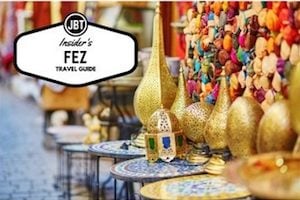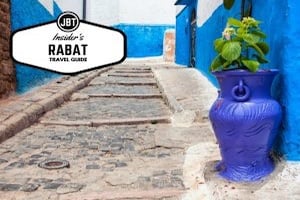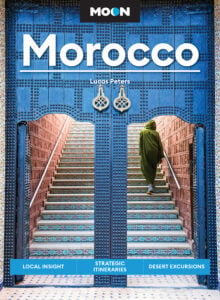
It’s 1578 and Morocco is at war with Portugal. On a fateful August day, the Moroccan forces wipe out 26,000 Portuguese men including the army’s commander, King Don Sebastian. Morocco’s commander, Sultan Abd El Malik survives to witness his kingdom’s crushing victory but perishes shortly thereafter on the battlefield – but not without first naming his youngest brother his successor.
Now, Ahmed el Mansour is sultan but he feels the desperate need to prove himself after his brother’s honorable death. It is this worry which leads him to build one of Morocco’s most spectacular structures: the El Badi Palace. Using a substantial ransom paid by the Portuguese for its prisoners of war and the workforce of the thousands of imprisoned Christians who filled the kingdom’s prisons at the time, Sultan Ahmed el Mansour spared no expense adorning the more than 350 rooms of his palace with marble, gold, onyx, ivory, cedar wood and semi-precious stones.
Today, the glorious palace, located in the city of Marrakech, is reduced to mere ruins, a haunting shell of its past splendor. But the vast structure which remains is still one of Morocco’s most visited historical sites with a grand courtyard and battered walls that tell the story of one of the country’s most glorious times.
“The Incomparable”
The palace’s name – Badi, which translates to “The Incomparable” – is by no means immodest. For over twenty five years, Ahmed el Mansour invested his time, money and expertise into this glorious project, importing exquisite materials such as Sudanese gold, ivory, Italian marble, and semi-precious stones and commissioning the best artisans from around the world to embellish each room.
At the center of it all stood the massive courtyard, measuring 130 meters in length and about the same in width. Filled with lush sunken gardens, refreshing fountains and sparkling pools in each corner, the patio was the sultan’s refuge and where many local festivities still take place today. On each side of the courtyard, majestic pavilions and secondary palaces were built and adorned with the finest materials. Each of the five main halls had a special name which derived from the ornamentation on its ceiling: the Green Dome featured a ceiling entirely covered with green tiles while that of the Crystal Dome’s was beautifully adorned with crystal stones. It was in the Koubba el Khamsiniyya (the hall of 50 marble columns) that the sultan resided.
The remaining 360 rooms which lined the central courtyard and extended beyond it were also sumptuously decorated in marble, ivory, gold, cedar wood carving, and semi-precious stones.
When construction of the magnificent palace was finally completed, Sultan Ahmed el Mansour held a grand opening ceremony to which he invited several ambassadors from the European powers as well as all the sheikhs of the kingdom. As his guests arrived and witnessed what some once described the Eighth Wonder of the World, the proud sultan turned to his court jester to ask for his opinion of the palace. The latter fatefully replied “Sidi, this will make a magnificent ruin”.
A Magnificent Ruin
Not more than 75 years later, Alaouite Sultan Mawlay Ismail had risen to power and he promptly became known for destroying many of the buildings in Marrakesh to use their materials in his own creations. The El Badi Palace was no exception to the rule and was soon ransacked by the sultan to build his own palace in Meknes, the new capital of the Moroccan kingdom.
The scale of the palace was such, however, that it took the sultan twelve years to finish looting the place. The palace was stripped of anything valuable and today little remains from its glory days but a vast empty space where sumptuous rooms, halls and gardens once stood.
Nonetheless, even in its ruined state, it’s possible to get a clear idea of the scale of the palace, with its high, stark walls encompassing humble traces of stately reception halls and other official chambers. Its picturesque sandstone ruins still provide a skeleton of what was once an opulent home and playground for the sultan and his court.
Visitors can enter via the palace’s gatehouse and walk through the vast courtyard with its large pools and sunken orchard gardens. Some of the highlights of the surviving rooms of the palace include the small underground passages leading to a dungeon with four cells where the sultan kept his prisoners and the Koubba el Khamsiniyya where several columns are still standing. For a better view of the palace and the surrounding winding streets of the Marrakesh medina, consider climbing up the ruined ramparts of the palace.
Monuments, Ruins, and History, Oh My!
On a guided visit of Marrakesh, you’ll have the opportunity to visit El Badi Palace with our local expert guide. Our private Morocco tours take you into the heart of each place. And, the focus isn’t always history or ruins, but cultural encounters, village visits and walks, enjoying a Sahara Desert adventure, among other activities. Check out some of our most popular routes, which include our best of Morocco itinerary, Ultimate Morocco, and even our trip into the Erg Chigaga region of the desert. Start by contacting our team to plan well ahead (as Morocco is becoming a very popular destination!).
Author:
 This article was authored by Maria Inês Pinto, a Portuguese freelancer born with a passion for writing and travel. She has spent her life hopping around different countries, having lived in Canada, the US, India and Ireland.
This article was authored by Maria Inês Pinto, a Portuguese freelancer born with a passion for writing and travel. She has spent her life hopping around different countries, having lived in Canada, the US, India and Ireland.








